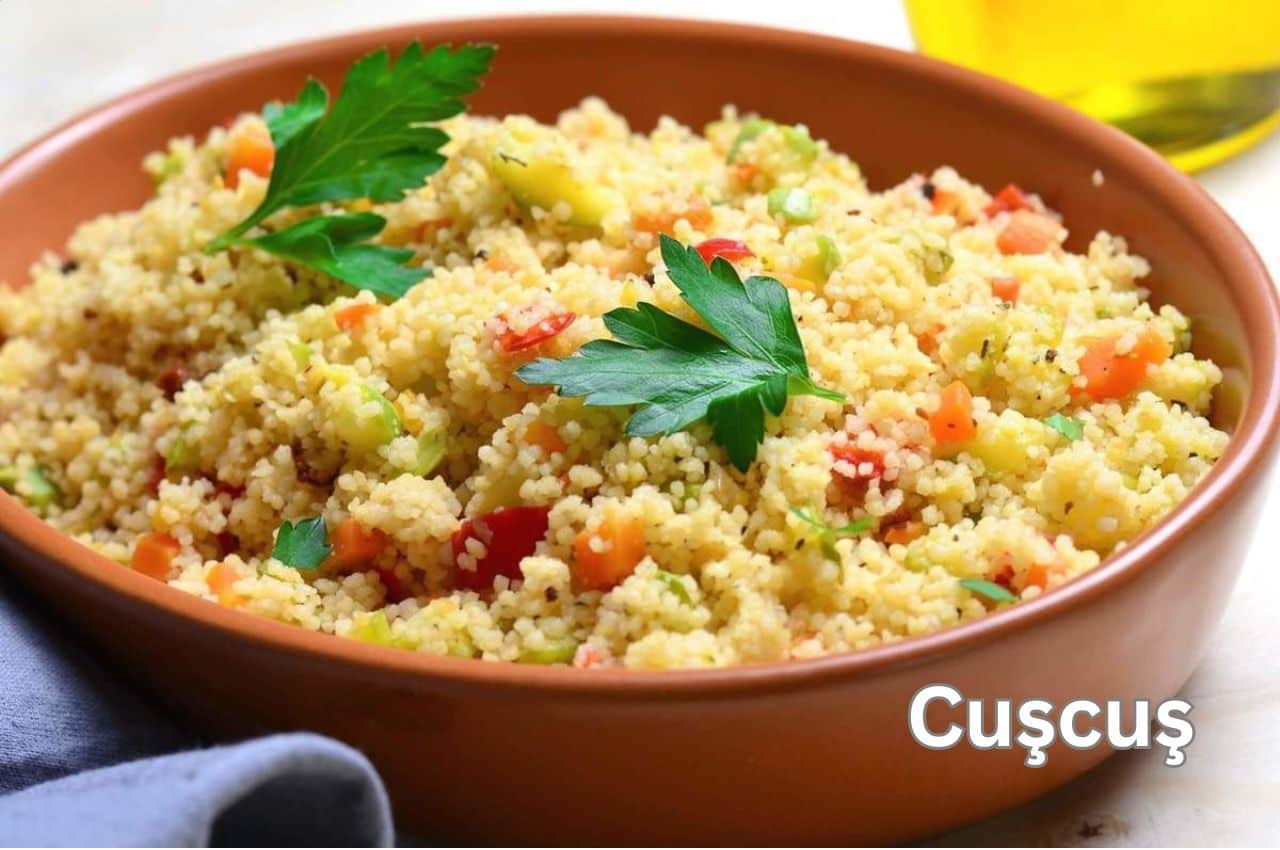Contents
Introduction
Cuşcuş, or couscous, is a versatile and beloved dish in North Africa. It is a staple in many countries, including Morocco, Algeria, Tunisia, and Libya. This tiny pasta, made from semolina wheat, is a culinary delight and a nutritional powerhouse.
This comprehensive guide will delve into the history, cultural significance, preparation methods, nutritional benefits, and various recipes associated with cuşcuş. By the end of this article, you will have a profound appreciation for this simple yet exquisite dish.
History and Cultural Significance
Origins of Cuşcuş
Cuşcuş has ancient roots that date back to the Berber tribes of North Africa. Archaeological findings suggest that cuşcuş was prepared as early as the 7th century. The name “cuşcuş” is derived from the Berber word “seksu,” which means “well-rolled” or “well-formed.” Over the centuries, cuşcuş spread across the Maghreb region and beyond, becoming a significant part of the culinary traditions in many Mediterranean countries.
Cultural Importance
Cuşcuş holds a special place in the hearts and kitchens of North African families. It is often prepared for communal meals, religious celebrations, and special occasions. In Morocco, for instance, cuşcuş is traditionally served on Fridays, the holy day of the week in Islam, after the Jumu’ah prayers. It symbolizes hospitality, unity, and sharing, as large gatherings of family and friends typically enjoy it.
Nutritional Benefits of Cuşcuş
Cuşcuş is not only delicious but also nutritious. These are a few of the essential nutritional advantages:
Rich in Carbohydrates
Cuşcuş is an excellent source of complex carbohydrates, which provide sustained energy. A single cup of cooked cuşcuş contains approximately 36 grams of carbohydrates, making it an ideal choice for those needing a quick and enduring energy boost.
Low in Fat
Cuşcuş is naturally low in fat, with less than 0.5 grams per cup. This makes it a heart-healthy option for those seeking a low-fat diet.
High in Fiber
Whole wheat cuşcuş is exceptionally high in dietary fiber, which aids in digestion and helps maintain healthy blood sugar levels. One cup of whole wheat cuşcuş can provide up to 5 grams of fiber.
Packed with Protein
Cuşcuş is a good source of plant-based protein, offering around 6 grams of protein per cup. This makes it a valuable addition to vegetarian and vegan diets.
Contains Essential Vitamins and Minerals
Cuşcuş is rich in essential vitamins and minerals, including B vitamins (such as thiamin, niacin, and folic acid), iron, and selenium. These nutrients are vital for maintaining good health and preventing various deficiencies.
How to Prepare Cuşcuş?
Preparing cuşcuş is straightforward, but various methods are depending on the type of cuşcuş and the desired texture. Here, we will explore the traditional steaming method and the quick-cooking method.
Traditional Steaming Method
The traditional method of preparing cuşcuş involves steaming it multiple times to achieve a light and fluffy texture. Here is a step-by-step guide:
- Ingredients:
- 2 cups of dry cuşcuş
- 2 cups of water
- 1 tablespoon of olive oil or butter
- 1 teaspoon of salt
- Preparation:
- Sprinkle the dry cuşcuş with water, olive oil or butter, and salt in a large bowl. Mix well.
- Allow the cuşcuş to absorb the water for about 10 minutes, then rub it between your hands to break up clumps.
- Steaming:
- Place the cuşcuş in the top part of a couscousiere (a special steamer for cuşcuş) or a steamer basket.
- Fill the bottom part of the couscousiere with water and bring it to a boil.
- Place the cuşcuş-filled top part over the boiling water, cover, and steam for 15-20 minutes.
- Remove the cuşcuş, fluff it with a fork, and let it cool for a few minutes.
- Repeat the steaming process twice, fluffing the cuşcuş between each steaming.
Quick-Cooking Method
For those short on time, the quick-cooking method is a convenient alternative:
- Ingredients:
- 1 cup of dry cuşcuş
- 1 cup of boiling water or broth
- 1 tablespoon of olive oil or butter
- 1 teaspoon of salt
- Preparation:
- Combine the dry cuşcuş, olive oil or butter, and salt in a heatproof bowl.
- Pour the boiling water or broth over the cuşcuş, cover the bowl, and let it sit for about 5 minutes.
- Fluff the cuşcuş with a fork to separate the grains.
Delicious Cuşcuş Recipes
Cuşcuş can be enjoyed in various dishes, from savory main courses to sweet desserts. Here are some popular recipes to try:
Moroccan Vegetable Cuşcuş
Ingredients:
- 1 cup of cuşcuş
- 1 zucchini, diced
- 1 carrot, diced
- 1 bell pepper, diced
- 1 onion, chopped
- 1 can of chickpeas, drained and rinsed
- 2 cups of vegetable broth
- 1 teaspoon of ground cumin
- 1 teaspoon of ground coriander
- 1 teaspoon of paprika
- 1/2 teaspoon of ground cinnamon
- Salt and pepper to taste
- Fresh parsley, chopped (for garnish)
Instructions:
- In a large pot, sauté the onion in olive oil until translucent.
- Add the zucchini, carrot, and bell pepper, and cook for about 5 minutes.
- Stir in the chickpeas, cumin, coriander, paprika, cinnamon, salt, and pepper.
- Pour in the vegetable broth and bring to a boil.
- Stir in the cuşcuş, cover, and remove from heat. Let it sit for 5 minutes.
- Fluff the cuşcuş with a fork and garnish with fresh parsley.
Lemon Herb Cuşcuş Salad
Ingredients:
- 1 cup of cuşcuş
- 1 cup of boiling water or broth
- 1/4 cup of olive oil
- Juice of 1 lemon
- 1 cucumber, diced
- 1 tomato, diced
- 1/4 cup of red onion, finely chopped
- 1/4 cup of fresh mint, chopped
- 1/4 cup of fresh parsley, chopped
- Salt and pepper to taste
Instructions:
- Combine the cuşcuş, olive oil, and lemon juice in a large bowl.
- Cover the boiling water or broth over the cuşcuş and let it sit for 5 minutes.
- Fluff the cuşcuş with a fork and let it cool.
- Add the cucumber, tomato, red onion, mint, and parsley. Mix well.
- Season with salt and pepper to taste.
Sweet Cuşcuş with Dried Fruits and Nuts
Ingredients:
- 1 cup of cuşcuş
- 1 cup of boiling water
- 1/4 cup of honey
- 1/4 cup of raisins
- 1/4 cup of dried apricots, chopped
- 1/4 cup of almonds, chopped
- 1/4 cup of pistachios, chopped
- 1/2 teaspoon of ground cinnamon
- 1/4 teaspoon of ground nutmeg
Instructions:
- In a large bowl, combine the cuşcuş and honey.
- Pour the boiling water over the cuşcuş, cover it, and let it sit for 5 minutes.
- Fluff the cuşcuş with a fork and let it cool.
- Add the raisins, dried apricots, almonds, pistachios, cinnamon, and nutmeg. Mix well.
Cuşcuş Around the World
Mediterranean and Middle Eastern Variations
While cuşcuş is most closely associated with North Africa, it has been embraced and adapted by many cultures around the Mediterranean and the Middle East. In these regions, cuşcuş is often paired with various ingredients and spices, reflecting local tastes and culinary traditions.
French Influence
France has a significant North African immigrant population, and cuşcuş has become a popular dish in French cuisine. It is often served in restaurants and homes, typically accompanied by a rich, flavorful stew of meat and vegetables.
Italian Fregola
In Italy, particularly in Sardinia, a similar pasta called fregola is made from semolina dough and toasted to give it a nutty flavor. Fregola is often used in soups and salads, much like cuşcuş.
Tips for Cooking Perfect Cuşcuş
- Fluffing: Fluff the cuşcuş with a fork after cooking to separate the grains and achieve a light, airy texture.
- Liquid Ratio: For the quick-cooking method, use a 1:1 ratio of cuşcuş to liquid, adjusting slightly based on personal preference.
- Seasoning: Season the cuşcuş with spices, herbs, or broth for added flavor.
- Steaming: For a more traditional approach, steam the cuşcuş multiple times for a tender, fluffy result.
Read Also! Spicyrranny Adventures: Discovering Global Spicy Delights
Conclusion
Cuşcuş is a remarkable dish that has transcended its North African origins to become a beloved staple worldwide. Its versatility, nutritional benefits, and rich cultural significance make it a valuable addition to any kitchen. Whether you prefer the traditional steaming method or the quick-cooking approach, cuşcuş offers endless possibilities for delicious and nutritious meals. From savory vegetable medleys to sweet desserts with dried fruits and nuts, there is a cuşcuş recipe to suit every palate. Embrace the culinary heritage of cuşcuş and enjoy exploring its diverse flavors and textures.
Understanding the history, cultural importance, and various preparation methods of cuşcuş will help you genuinely appreciate this humble yet extraordinary dish. So, gather your ingredients, get creative, and savor the delightful world of cuşcuş.
Ethan Cole is a versatile writer at hsnime.co.uk, offering fresh perspectives and engaging content across various topics. With a passion for creativity and knowledge, Ethan aims to provide insightful articles that resonate with a diverse audience.






